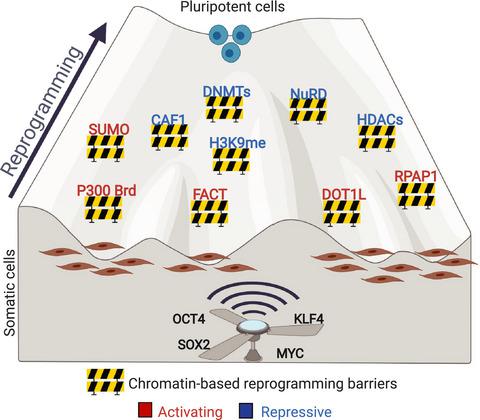Our official English website, www.x-mol.net, welcomes your feedback! (Note: you will need to create a separate account there.)
Going up the hill: chromatin-based barriers to epigenetic reprogramming
The FEBS Journal ( IF 5.4 ) Pub Date : 2020-11-15 , DOI: 10.1111/febs.15628 Dilşad H Arabacı 1 , Gizem Terzioğlu 2 , Büşra Bayırbaşı 1 , Tamer T Önder 1
The FEBS Journal ( IF 5.4 ) Pub Date : 2020-11-15 , DOI: 10.1111/febs.15628 Dilşad H Arabacı 1 , Gizem Terzioğlu 2 , Büşra Bayırbaşı 1 , Tamer T Önder 1
Affiliation

|
The establishment and maintenance of cellular identity are crucial during development and tissue homeostasis. Epigenetic mechanisms based largely on DNA methylation and histone modifications serve to reinforce and safeguard differentiated cell states. Somatic cell nuclear transfer (SCNT) or transcription factors such as Oct4, Sox2, Klf4, c-MYC (OSKM) can erase somatic cell identity and reprogram the cells to a pluripotent state. In doing so, reprogramming must reset the chromatin landscape, silence somatic-specific gene expression programs, and, in their place, activate the pluripotency network. In this viewpoint, we consider the major chromatin-based barriers for reprogramming of somatic cells to pluripotency. Among these, repressive chromatin modifications such as DNA methylation, H3K9 methylation, variant histone deposition, and histone deacetylation generally block the activation of pluripotency genes. In contrast, active transcription-associated chromatin marks such as DOT1L-catalyzed H3K79 methylation, FACT-mediated histone turnover, active enhancer SUMOylation, and EP300/CBP bromodomain-mediated interactions act to maintain somatic-specific gene expression programs. We highlight how genetic or chemical inhibition of both types of barriers can enhance the kinetics and/or efficiency of reprogramming. Understanding the mechanisms by which these barriers function provides insight into how chromatin marks help maintain cell identity.
中文翻译:

上山:表观遗传重编程的基于染色质的障碍
细胞特性的建立和维持在发育和组织稳态过程中至关重要。主要基于 DNA 甲基化和组蛋白修饰的表观遗传机制有助于加强和保护分化的细胞状态。体细胞核转移 (SCNT) 或转录因子,如 Oct4、Sox2、Klf4、c-MYC (OSKM) 可以消除体细胞身份并将细胞重新编程为多能状态。在这样做时,重编程必须重置染色质景观,使体细胞特异性基因表达程序沉默,并取而代之的是激活多能性网络。从这个角度来看,我们考虑了将体细胞重编程为多能性的主要基于染色质的障碍。其中,抑制性染色质修饰,如 DNA 甲基化、H3K9 甲基化、变异组蛋白沉积、和组蛋白去乙酰化通常会阻止多能性基因的激活。相比之下,活性转录相关染色质标记,如 DOT1L 催化的 H3K79 甲基化、FACT 介导的组蛋白转换、活性增强子 SUMOylation 和 EP300/CBP 溴结构域介导的相互作用,用于维持体细胞特异性基因表达程序。我们强调了这两种屏障的遗传或化学抑制如何增强重编程的动力学和/或效率。了解这些屏障功能的机制可以深入了解染色质标记如何帮助维持细胞身份。和 EP300/CBP 溴结构域介导的相互作用起到维持体细胞特异性基因表达程序的作用。我们强调了这两种屏障的遗传或化学抑制如何增强重编程的动力学和/或效率。了解这些屏障功能的机制可以深入了解染色质标记如何帮助维持细胞身份。和 EP300/CBP 溴结构域介导的相互作用起到维持体细胞特异性基因表达程序的作用。我们强调了这两种屏障的遗传或化学抑制如何增强重编程的动力学和/或效率。了解这些屏障功能的机制可以深入了解染色质标记如何帮助维持细胞身份。
更新日期:2020-11-15
中文翻译:

上山:表观遗传重编程的基于染色质的障碍
细胞特性的建立和维持在发育和组织稳态过程中至关重要。主要基于 DNA 甲基化和组蛋白修饰的表观遗传机制有助于加强和保护分化的细胞状态。体细胞核转移 (SCNT) 或转录因子,如 Oct4、Sox2、Klf4、c-MYC (OSKM) 可以消除体细胞身份并将细胞重新编程为多能状态。在这样做时,重编程必须重置染色质景观,使体细胞特异性基因表达程序沉默,并取而代之的是激活多能性网络。从这个角度来看,我们考虑了将体细胞重编程为多能性的主要基于染色质的障碍。其中,抑制性染色质修饰,如 DNA 甲基化、H3K9 甲基化、变异组蛋白沉积、和组蛋白去乙酰化通常会阻止多能性基因的激活。相比之下,活性转录相关染色质标记,如 DOT1L 催化的 H3K79 甲基化、FACT 介导的组蛋白转换、活性增强子 SUMOylation 和 EP300/CBP 溴结构域介导的相互作用,用于维持体细胞特异性基因表达程序。我们强调了这两种屏障的遗传或化学抑制如何增强重编程的动力学和/或效率。了解这些屏障功能的机制可以深入了解染色质标记如何帮助维持细胞身份。和 EP300/CBP 溴结构域介导的相互作用起到维持体细胞特异性基因表达程序的作用。我们强调了这两种屏障的遗传或化学抑制如何增强重编程的动力学和/或效率。了解这些屏障功能的机制可以深入了解染色质标记如何帮助维持细胞身份。和 EP300/CBP 溴结构域介导的相互作用起到维持体细胞特异性基因表达程序的作用。我们强调了这两种屏障的遗传或化学抑制如何增强重编程的动力学和/或效率。了解这些屏障功能的机制可以深入了解染色质标记如何帮助维持细胞身份。



























 京公网安备 11010802027423号
京公网安备 11010802027423号